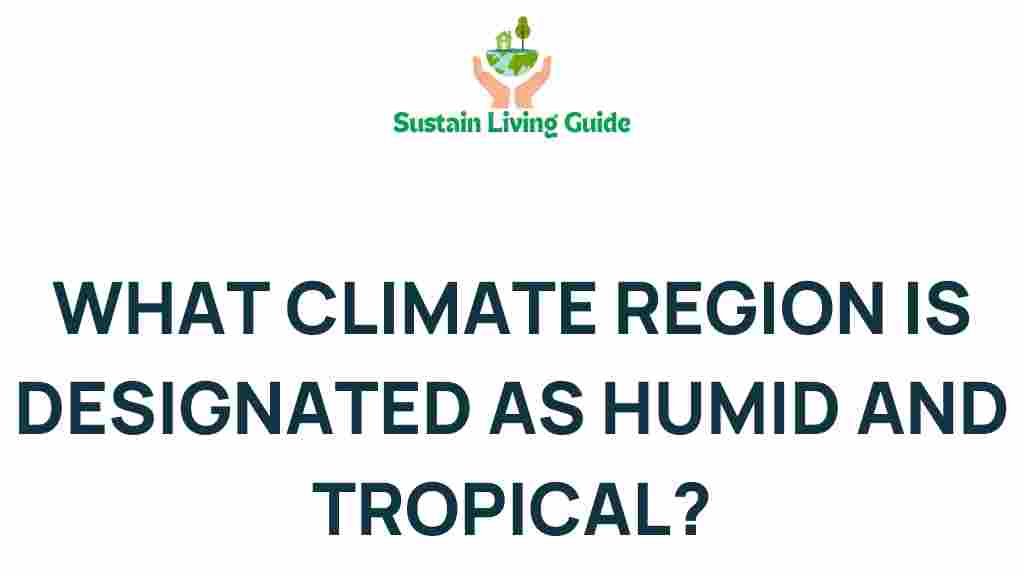Tropical Climate: Understanding the Essentials
The tropical climate is a fascinating and diverse region characterized by warm temperatures and high humidity throughout the year. This climate type is predominantly found near the equator and is known for its lush vegetation, diverse ecosystems, and unique weather patterns. In this article, we will unveil the secrets of the humid and tropical climate region, exploring its features, benefits, challenges, and how it impacts both the environment and human life.
What Defines a Tropical Climate?
A tropical climate is primarily defined by the following characteristics:
- Temperature: Average monthly temperatures remain above 18°C (64°F) throughout the year.
- Rainfall: High annual rainfall, often exceeding 1750 mm (69 inches), with distinct wet and dry seasons.
- Humidity: High humidity levels ranging from 70% to 90% contribute to the overall warmth and moisture of the region.
- Vegetation: Dense forests, such as rainforests and mangroves, thrive due to the abundant moisture and warmth.
The Types of Tropical Climate
Within the tropical climate, there are several subcategories that define specific conditions:
- Tropical Rainforest Climate (Af): Characterized by year-round rainfall, this climate supports dense forests rich in biodiversity.
- Tropical Monsoon Climate (Am): Experiences a short dry season, with heavy rainfall during the monsoon months, leading to lush vegetation.
- Tropical Savanna Climate (Aw): Features distinct wet and dry seasons, often supporting grasslands and scattered trees.
The Benefits of a Tropical Climate
The tropical climate offers numerous advantages, making it a unique and vibrant region:
- Biodiversity: Home to more than half of the world’s plant and animal species, tropical regions are crucial for global biodiversity.
- Agriculture: The warm temperatures and abundant rainfall allow for year-round farming, supporting crops like rice, bananas, and cocoa.
- Tourism: Tropical destinations attract millions of tourists each year, drawn by their beautiful landscapes, exotic wildlife, and rich cultures.
Exploring Tropical Ecosystems
The tropical climate fosters a variety of ecosystems, each with unique features:
- Tropical Rainforests: Dense and lush, these forests are crucial for carbon storage and oxygen production.
- Coral Reefs: Found in tropical oceans, coral reefs support diverse marine life and are vital for coastal protection.
- Wetlands: These areas are rich in biodiversity and play a critical role in water filtration and flood control.
Challenges of Tropical Climate Regions
Despite its benefits, the tropical climate also presents several challenges:
- Natural Disasters: Tropical regions are prone to hurricanes, floods, and other natural disasters that can devastate communities and ecosystems.
- Disease: The warm, humid environment is conducive to the spread of vector-borne diseases like malaria and dengue fever.
- Deforestation: Rapid urbanization and agriculture have led to significant deforestation, threatening biodiversity and contributing to climate change.
How to Adapt to a Tropical Climate
Adapting to a tropical climate is essential for residents and businesses alike. Here are some strategies:
- Building Design: Use materials and designs that promote ventilation and cooling, such as high ceilings and large windows.
- Water Management: Implement rainwater harvesting systems and sustainable irrigation practices to manage water resources effectively.
- Agricultural Practices: Utilize crop rotation and agroforestry to maintain soil fertility and combat pests.
Step-by-Step Guide to Thriving in a Tropical Climate
If you’re looking to thrive in a tropical climate, follow this step-by-step guide:
Step 1: Understand the Weather Patterns
Familiarize yourself with local weather patterns, including the timing of wet and dry seasons. This knowledge will help you plan activities and manage resources effectively.
Step 2: Choose the Right Clothing
Select lightweight, breathable fabrics that wick moisture and keep you cool. Lightweight cotton or linen clothing is ideal for hot, humid conditions.
Step 3: Stay Hydrated
Drink plenty of water to stay hydrated, especially during hot seasons. Consider using water purification methods to ensure safe drinking water.
Step 4: Protect Against Insects
Use insect repellent and wear protective clothing to guard against mosquito bites, which can transmit diseases.
Step 5: Maintain Your Property
Regularly inspect and maintain your home to prevent mold growth and structural damage caused by humidity.
Troubleshooting Common Issues in Tropical Climates
Living in a tropical climate can present specific challenges. Here are some common issues and how to troubleshoot them:
Mold and Mildew Growth
Issue: High humidity levels can lead to mold and mildew growth in homes.
Solution: Use dehumidifiers, improve ventilation, and clean affected areas with mold-resistant products.
Pest Infestations
Issue: Tropical climates often attract pests, including termites and mosquitoes.
Solution: Seal cracks in walls, use pest control measures, and maintain a clean environment to deter infestations.
Water Management Problems
Issue: Heavy rainfall can lead to flooding and water accumulation.
Solution: Ensure proper drainage systems and consider rainwater harvesting solutions to manage excess water.
Conclusion: Embracing the Tropical Climate
The tropical climate is a unique and vibrant region that offers numerous benefits and challenges. Understanding its features, adapting to its conditions, and effectively managing the issues that arise can help residents thrive in these beautiful areas. From exploring rich ecosystems to enjoying the agricultural bounty, there is much to appreciate about the tropical climate.
By embracing the characteristics of the tropical climate, individuals can enjoy a fulfilling lifestyle while contributing to the sustainability and preservation of this vital region. For more information on how to adapt to various climates, check out this resource.
Explore the wonders of the tropical climate, and discover how you can play a part in protecting its beauty and diversity for generations to come!
This article is in the category Eco-friendly and created by SustainLivingGuide Team

2 thoughts on “Unveiling the Secrets of the Humid and Tropical Climate Region”